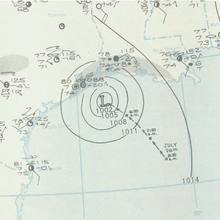1943 Surprise Hurricane
 Surface weather analysis of the hurricane on July 27, near peak intensity. | |
| Meteorological history | |
|---|---|
| Formed | July 25, 1943 |
| Dissipated | July 29, 1943 |
| Category 2 hurricane | |
| 1-minute sustained (SSHWS/NWS) | |
| Highest winds | 105 mph (165 km/h) |
| Lowest pressure | 967 mbar (hPa); 28.56 inHg |
| Overall effects | |
| Fatalities | 19 |
| Damage | $17 million (1943 USD) |
| Areas affected | Louisiana, Texas |
| IBTrACS | |
Part of the 1943 Atlantic hurricane season | |
The 1943 Surprise Hurricane was the first hurricane to be entered by a
Because the storm occurred during
Meteorological history

Tropical storm (39–73 mph, 63–118 km/h)
Category 1 (74–95 mph, 119–153 km/h)
Category 2 (96–110 mph, 154–177 km/h)
Category 3 (111–129 mph, 178–208 km/h)
Category 4 (130–156 mph, 209–251 km/h)
Category 5 (≥157 mph, ≥252 km/h)
Unknown
A partial
Later on July 27, the first ever
Hurricane hunting
This was the first hurricane that a reconnaissance aircraft intentionally flew into. During the morning hours of July 27, British pilots were training at
Censorship
The hurricane occurred during
Impact and aftermath
In Louisiana, light winds were observed, with gusts of 36 mph (58 km/h) at both Burrwood and Lake Charles. Locally heavy rains were reported in some areas, with a 24-hour precipitation total of 7.65 inches (194 mm) in DeQuincy on July 28.[4]

The storm brought strong winds to Texas, with gusts up to 132 mph (212 km/h) reported at the cooling towers at the

Heavy rainfall was observed in some areas of eastern Texas, with up to 19 inches (480 mm) in Port Arthur. There, numerous homes were flooded with 6 to 24 inches (150 to 610 mm) of water, which included damage to furnishings, electric motors and automobiles. In downtown Galveston, a number of streets were inundated with rainwater, though flooding damage was relatively minor.[3] Two children's polio hospitals suffered leaking roofs and water damage, forcing patients to be evacuated by staff and University of Texas Medical Branch students.[7] About 90 percent of all house and buildings in Texas City suffered either water damage or complete destruction, including plant sites producing war materials. However, they were discouraged from going to shelters due to a polio epidemic there. In Galveston Bay, wind-driven waves flooded the western and southern shores. However, northerly winds across the bay resulted in tides being extremely low. On Galveston Island, a storm surge of 6 feet (1.8 m) was observed. Offshore, the United States Army Corps of Engineers’s hopper dredge Galveston broke up after being smashed against the north jetty, causing 11 fatalities. The tug Titan began sinking offshore Port Arthur. Three members of the crew drowned after attempting to board a rubber raft, while another person died before the remainder of the crew reached the shore. Overall, the storm killed 19 people and caused $17 million (1943 USD) in damage to the Houston area.[3]
Following the storm, residents were warned to boil their water and be cautious of potential
See also
- 1941 Texas hurricane
- Hurricane Alicia
- Hurricane Otis - Another surprise hurricane that hit Acapulco Mexico in 2023
References
- ^ Weather Bureau (Report). Washington, D.C.: Atlantic Oceanographic and Meteorological Laboratory; National Oceanic and Atmospheric Administration. pp. 179–1980. Retrieved January 1, 2014.
- ^ a b c d "Atlantic hurricane best track (HURDAT version 2)" (Database). United States National Hurricane Center. April 5, 2023. Retrieved April 19, 2024.
 This article incorporates text from this source, which is in the public domain.
This article incorporates text from this source, which is in the public domain.
- ^ a b c d e f g h Lew Fincher and Bill Read (May 24, 2010). The 1943 "Surprise" Hurricane. National Weather Service Houston/Galveston, Texas (Report). Dickinson, Texas: National Oceanic and Atmospheric Administration. Retrieved January 1, 2014.
- ^ David M. Roth (April 8, 2010). Louisiana Hurricane History (PDF). Weather Prediction Center (Report). College Park, Maryland: National Oceanic and Atmospheric Administration. p. 35. Retrieved January 1, 2014.
- ^ a b "Severe Storm Hits City" (PDF). The Daily News. July 28, 1943. Archived from the original (PDF) on July 13, 2004. Retrieved January 1, 2014.
- ^ David M. Roth (January 17, 2010). Texas Hurricane History (PDF). Weather Prediction Center (Report). College Park, Maryland: National Oceanic and Atmospheric Administration. p. 46. Retrieved January 1, 2014.
- ISBN 978-1603441650. Retrieved January 3, 2014.
- ^ "Ten Are Drowned As Dredge Sinks" (PDF). The Daily News. July 29, 1943. Archived from the original (PDF) on January 18, 2010. Retrieved January 1, 2014.

